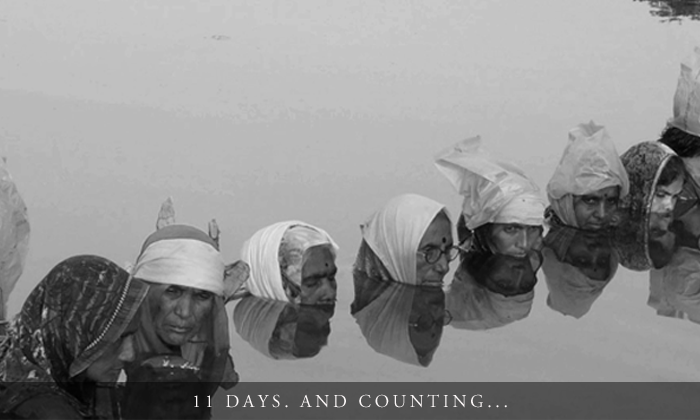But of course, in India at sixty-plus, one can consume their suffering, with other delicacies, writes Aritra Bhattacharya.
What happens to the human body when it stays in contact with water for hours on end?
Some of us, who may have had to work with water as part of our daily chores, might say that the colour drains out, that the body turns whitish, or the skin gets wrinkled, and the body starts itching. Yet, this rudimentary contact with water for a few hours may not equip us to comprehend the state the body might be in when a person has been standing in water for eleven days.
You heard it right. Eleven days. And counting.
Counting as the water rises, gradually. From the knee to the thighs to the waist to the tummy to the chest to the neck…
Does the mind also stop working then? Or does it find ways to subvert the immersion by imagining what it might be after the water has receded? Does it think of the open sky and the vast fields surrounding the water? Or does it think of death, with morbidity announcing itself in the body’s assault with water? Does the mind take cues from the body, or try to push it to the extremities of endurance?
Perhaps, we may never know. Perhaps, even if we do, we may never find the words to express what we know. After all, language is a funny thing: experiences can be narrativised when they refer to something everyone else has felt; the words must refer to something in the common pool of knowledge. How then do we talk of experience that is outside this common pool? That does not have any reference?
But of course, in India at sixty-plus, one can consume their suffering, with other delicacies. Like when one goes to the Times of India article about the jal satyagraha, one might be greeted by a video ad of the travel portal goibibo.com, which is trying to sell the best deal on a vacation to Goa.
How then can we construct images that tell us, explain to us, or help us understand the state of mind and body, together or separately, of the 51 people who have been standing under water for 11 days now, protesting against the submergence of their lands by the Omkareshwar dam.
For the record, the Omkareshwar dam in Madhya Pradesh’s Khandwa district is one of the several big dams on Narmada, built by the Narmada Hydroelectric Development Corporation (NHDC), which is a joint venture between the National Hydroelectric Power Corporation and the government of Madhya Pradesh. The State Government and the project authorities intend to raise the water level of the Omkareshwar dam from 189 metres to 193 meters. According to the Narmada Bachao Andolan, almost 2500 landholder families will lose their lands in this fresh submergence; despite the Supreme Court’s directions to authorities to allot land for land well in advance of the completion of dam construction, the 2500 families have not been rehabilitated. Instead, in a show of wanton disregard for people’s lives and livelihoods, the dam authorities raised the water level by 1.5 metres on August 31.And therefore, the jal satyagraha has continued.
But why would the people choose this extreme form of protest? What warrants these villagers putting their own lives in peril in this manner? To understand, we might need to access their mindset. And for that we might need a language that can express what they feel.
59 years! How did this prisoner ‘feel’ time?
How do the 51 villagers standing in water for 11 days feel time? We do not have an Amar Kanwar video to help us, however excruciatingly, posit an answer. Like we do not have an answer to how Irom Sharmila feels time in her more than a decade long fast.
Hence, we can only grope in the dark.
Hoping to land ourselves in some kind of abyss that contextualizes their sufferings for us.
And helps explain why they are so far away from the mainstream.
And why India at sixty-plus isn’t a great place to be.
But of course, in India at sixty-plus, one can consume their suffering, with other delicacies. Like when one goes to the Times of India article about the jal satyagraha, one might be greeted by a video ad of the travel portal goibibo.com, which is trying to sell the best deal on a vacation to Goa. In this bustling independent nation, then, ‘we, the people’ can choose whether to consume a lazing, laidback, chilled-out vacation by the sea, or the grief-laced depressing story of the ‘poor’ villagers in some forsaken territory. Better still, we can consume both. In either case, we won’t be far from water!And while we think about which of the options works best for us, let us keep in the mind the immense ‘pressure’ that these ‘protestors’ function under: For them, there is no escape route—they carry the burden of fighting on behalf of thousands of others who look up to them, lionize them. If they quit the resistance, they let their fellow mates down; they push them into a turn from which there is no resurrection. If they don’t, they lose their lives in the face of a stoic State that raises the water level till it submerges all life on the fringes. Either way, they have no choice!


